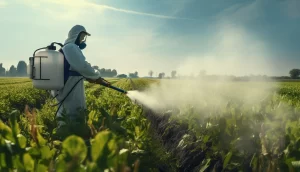The agricultural industry has always been integral to global economies and food supplies. Yet, it has also been a major contributor to environmental concerns. As we look toward the future, it is imperative that we envision a world that embraces sustainable agricultural chemicals and responsible farming practices. This article delves into the topic, analyzing key aspects, and making projections based on current trends and data.
Sustainable Agricultural Chemicals: A Growing Need
The call for sustainable agricultural chemicals isn’t merely about following a green trend. Rather, it’s a necessity brought about by the acknowledgment of the deleterious effects of traditional farming practices on the environment and public health. An estimated 5.6 billion pounds of pesticides are used globally each year, creating a vast environmental footprint. As the agriculture sector responds to this, we see a gradual shift towards sustainable alternatives.
Eco-Friendly Farming Solutions
Alternative eco-friendly farming solutions are on the rise. These include biopesticides, biostimulants, and biofertilizers, which are derived from natural materials like microorganisms, plants, and minerals. They have shown potential to replace, or at least supplement, synthetic agricultural chemicals, reducing environmental impact while maintaining crop yields.
Biopesticides
 In global quest for more sustainable agricultural practices, biopesticides are emerging as a promising solution. Unlike conventional pesticides, which often have detrimental effects on the environment and non-target species, biopesticides are derived from natural materials such as animals, plants, bacteria, and certain minerals.
In global quest for more sustainable agricultural practices, biopesticides are emerging as a promising solution. Unlike conventional pesticides, which often have detrimental effects on the environment and non-target species, biopesticides are derived from natural materials such as animals, plants, bacteria, and certain minerals.
Recent market reports show an increasing global demand for biopesticides. The growing concern over harmful chemical pesticides, rising demand for organic food, and the introduction of innovative biopesticide solutions are key drivers for this growth. Notable companies like BASF SE and Marrone Bio Innovations are investing significantly in the development of innovative biopesticides. For example, BASF’s Serifel biofungicide offers broad-spectrum protection against a range of fungal and bacterial diseases, while Marrone’s Grandevo biopesticide demonstrates effectiveness against a wide array of pests.
Biostimulants and Biofertilizers
Biostimulants and biofertilizers are two other key components in the toolkit of sustainable agriculture. Biostimulants, which include diverse substances and microorganisms, enhance plant growth, resilience, and nutrient use efficiency. Biofertilizers, on the other hand, utilize beneficial microorganisms to enhance soil fertility by fixing atmospheric nitrogen and solubilizing phosphorus.
Leading companies like Novozymes and Isagro are making significant strides in this sector. Novozymes, for example, has developed a range of microbial solutions that can stimulate plant growth and combat pests. Isagro’s Auxym biostimulant enhances nutrient absorption in crops, improving both yield and quality.
Implementing Responsible Farming Practices
The successful implementation of responsible farming practices calls for a multifaceted approach, with sustainable agricultural chemicals forming just one part of the solution. Emphasizing crop rotation, cover cropping, and precision agriculture techniques can help create a more sustainable agricultural system.
Responsible Use of Agricultural Chemicals
Despite the emergence of greener alternatives, the complete elimination of synthetic agricultural chemicals isn’t feasible in the near term. Therefore, it’s crucial to focus on their responsible use. Precision agriculture technologies, like GPS and remote sensing, can help in applying chemicals only where needed, reducing waste and environmental impact.
The Impact of Sustainable Agricultural Chemicals on Environment
Mitigating Environmental Risks: The transition to sustainable agricultural chemicals helps mitigate the environmental risks associated with conventional, chemical-based agriculture1.
Maintaining Biodiversity: Biopesticides, which degrade quickly and minimize environmental contamination, help maintain biodiversity, particularly beneficial insects.
Improving Soil Health: Biostimulants and biofertilizers enrich the soil with beneficial microorganisms, improving its overall health.
Reducing Nutrient Runoff: These sustainable solutions improve nutrient uptake by plants, reducing the need for synthetic fertilizers and mitigating nutrient runoff into water bodies.
Cleaner Water Bodies: Reduced nutrient runoff leads to cleaner rivers and oceans, supporting healthier marine ecosystems.
Addressing Climate Change: The use of sustainable agricultural chemicals reduces dependency on synthetic fertilizers, cutting down greenhouse gas emissions associated with their production. Plus, healthier soils can store more carbon, further contributing to climate mitigation.
Promoting Responsible Farming: Overall, the use of sustainable agricultural chemicals marks a significant move towards responsible farming, promising a healthier planet and a more sustainable future for agriculture.
Sustainable Agricultural Chemicals in Organic Farming
Organic farming, a rapidly growing sector within the global agriculture industry, greatly relies on sustainable agricultural chemicals for success. Biopesticides, biostimulants, and biofertilizers are key components in organic farming, offering a natural alternative to synthetic chemicals.
Similarly, biostimulants and biofertilizers help to maintain soil health, promote plant resilience, and increase nutrient utilization. By improving nutrient uptake, these sustainable solutions lead to healthier crops, enhanced yields, and a robust soil ecosystem essential for long-term agricultural productivity.
As the world continues to shift towards more sustainable farming practices, these sustainable agricultural chemicals will remain indispensable in organic farming. Their crucial role in balancing productivity and environmental sustainability is vital in feeding a growing population, all while preserving our planet for future generations.
Technological Innovations in Sustainable Agriculture
Technology has been playing an increasingly significant role in promoting sustainable farming practices. Precision agriculture technologies, including IoT devices, GPS-guided tractors, and drones, are facilitating more accurate use of resources, including sustainable agricultural chemicals. Moreover, data-driven farming allows for more efficient pest management, water conservation, and overall resource optimization.
Data-Driven Farming and Sustainable Agriculture
Harnessing the power of Big Data is revolutionizing farming practices. Predictive analytics can help anticipate pest outbreaks, identify soil deficiencies, and even optimize crop rotations. This data-driven approach can significantly reduce the amount of chemicals required, further promoting sustainability in the agricultural sector.
Leading Companies in Sustainable Agricultural Chemicals
Several key players in the agricultural sector are investing heavily in sustainable agricultural chemicals and responsible farming practices. Notable companies include Bayer AG, BASF SE, Syngenta AG, Corteva Agriscience, and Marrone Bio Innovations.
Bayer AG
Bayer AG, a German multinational pharmaceutical and life sciences company, has been a frontrunner in promoting sustainable farming practices. Its ‘Bayer Carbon Initiative’ aims to reduce field greenhouse gas emissions by 30% by 2030. In 2021, Bayer announced its commitment to generating 1.3 billion euros in annual sales by 2030 from products that contribute to sustainable agriculture. The company’s financial data for Q1 2023 reported a steady growth with net income rising to 1.45 billion euros.
BASF SE
Another significant player, BASF SE, focuses on creating chemistry for a sustainable future. Its agricultural solutions division has pioneered many eco-friendly products, such as Serifel® biofungicide4. In recent financial news, BASF’s agricultural solutions segment saw a 10% increase in sales in Q1 2023.
Syngenta AG
Syngenta AG, a global Swiss agribusiness company, has been driving innovation in the sustainable agricultural chemicals sector. Their product, AMPEXIO, is a biopesticide offering robust protection against downy mildew. Their financial report for 2022 showed a revenue growth of 2% reaching $14.35 billion.
Corteva Agriscience
Corteva Agriscience, an American agricultural chemical and seed company, has a robust portfolio of sustainable farming products. Their 2022 commitment to make 100% of their product portfolio available in easy-to-use formats by 2030 aims to reduce waste and enhance safety. In Q1 2023, Corteva Agriscience reported net sales of $4.2 billion, up 6% from the same period in the prior year.
Marrone Bio Innovations
Marrone Bio Innovations, a pioneer in the rapidly evolving biopesticide industry, offers a range of environmentally responsible pest management solutions. In a recent case study, their biopesticide Grandevo was utilized in a Florida citrus grove, resulting in increased yields and reduced reliance on traditional pesticides10. The company reported a 13% increase in revenue in Q1 2023, reaching $12 million.
The Road Ahead
The future of agriculture seems promising with the advent of sustainable agricultural chemicals and responsible farming practices. The journey to sustainable agriculture is a collective effort, requiring the participation of farmers, researchers, policy-makers, and consumers. As we venture into this new era of agriculture, it’s clear that sustainability isn’t just an option, but a necessity. Major companies are leading the way, developing innovative solutions that are both economically viable and environmentally friendly. Despite certain challenges, the global adoption of these sustainable practices continues to grow, promising a healthier planet and a more sustainable agricultural industry. As we witness this transformative shift, it becomes evident that sustainability is not just an option but a necessity, and it is up to us all—researchers, policy-makers, and consumers—to play our part in promoting and supporting this crucial evolution.
